Content warning: Self harm, suicide, depression
I don’t know how to write this one, you know. I had fun with meatwatch, delved into family history with the knights, did a little personal reflection after GHO. Then I bought the Lancer and thought “now THIS is an article!”. I started writing about politics and faith and magic, a paragraph every time I completed a component. And it felt hollow, because I was trying to write for you.
So I trashed the article, and I scrapped my plans for the lancer. I stripped components of paint, chucked out inspiration and the idea that I could deconstruct the knight-in-armour, thought about making offerings to vestas and river spirits and laughed at myself. Then I built this thing and wrote about it.
Before diving in to what I once uncharitably described as “Let’s do therapy through Warhammer 40k”, there’s a little atmospheric music about this model which I thought I would share with you to help set the mood:
The Hoo
I started properly thinking about the lancer in a very particular time and place. I was at Sutton Hoo in the high summer, listening to a man ramble on enthusiastically about a deeply political history of war, colonialism, edwardian to between-the-wars aristocracy and the nouveau riche and I felt like I wanted to scream. This place, that was once a marker of grief and sorrow and rage, where a father buried his son and then was buried in turn by his people, where christianity and paganism swirled and fed on one another, where one set of my ancestors rested from murdering another set, felt dead. So drained of meaning. Sometimes we’re told that nothing is ever important, a model is just a model and a novel is just a story. That nothing ever means anything or sparks introspection. That history is just things that happened and, as a result, is always perfectly neutral and safe, suborned in service of the economic, sexual, political and racial status quo.
What shite.
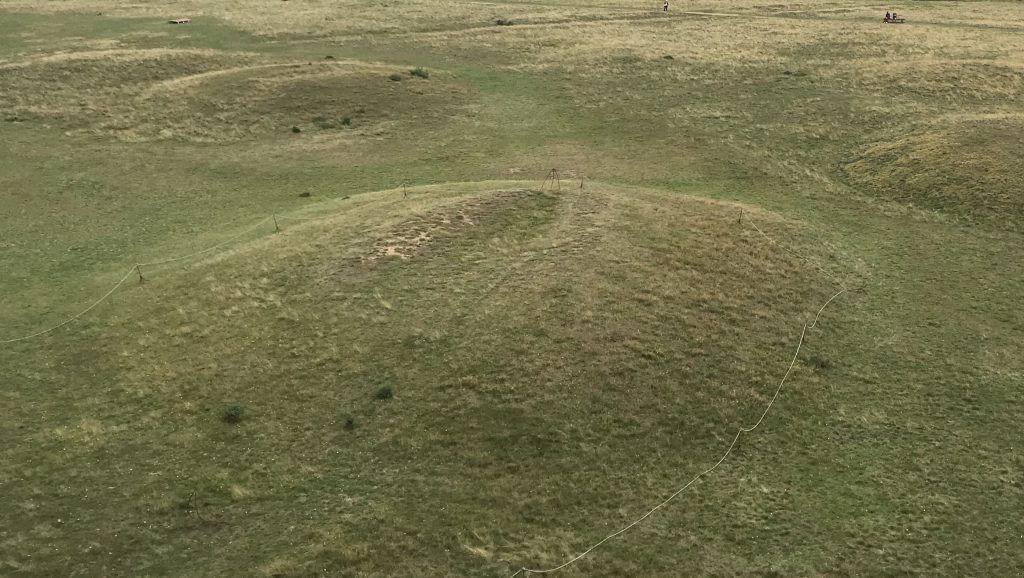
Beowulf
The idea that we can – or should – keep politics, or belief, or sexuality, or identity out of our hobby is strangling, suffocating. It’s the same idea that tells us to hide in the workplace, in public or even in politics. That whatever you are should go back in the box where it cannot be seen, because it doesn’t belong in the space you’ve brought it to and that wishing to change this is immoral or impossible. I am capable – we are capable – of more than we do, but we are carefully taught not to believe this. I will no longer tolerate this in my life, my politics or my Warhammer. So I started building.

This model is me. It’s about who I am and who I was and who I want to be. I earnestly believe we put ourselves into our hobby (and our writing) every time we pick up the brush. We pour meaning into models from the most involved conversions and bespoke schemes to straight from the box and painted accordingly. None of us can escape the trap of the hermeneutic cycle. I built and wrote this in fits and starts because that’s what was happening – something wouldn’t feel quite right, and I would change the plastic and the words until it felt right, so every component bears my mark, and nothing is as it was.
Life
Marks became the refrain really. I wanted to brand the model and make it clearly, blazingly, me, because I need to do that with myself too. I define myself relationally and when I think of myself I exist in the gaps left by competing obligations. I am a father, a husband, a son, a brother, a friend, a colleague, a goonhammer writer for some reason. With those things forming a mold, the thin scrape of ATCG that I actually am is held into the vague shape of a man. Even in my own head, I am defined by the actions of others, and that’s not a place I want to be.
Relational identity is damaging for me as I have spent a lot of my life defining myself through one other and one action. There was much love in my childhood and there remains much love in my life and I celebrate it, but I struggle sometimes to dwell in it, because there was much in my childhood that wasn’t love. I have often struggled with the term “abuse survivor” because I did not believe I did survive. Someone did, but not the kid that I was – or the man I should have been. It has taken me a long time to realise how fucked up that thought is, and I’m working on it. I need help to do that, to refute and deny the thought space in my mind, and the Lancer is part of that. I would like to be a person. On my own merit, untouched by the past. Until I can think that easily and freely, I’ll make it in plastic.

Of being young; that it can’t come again
– Philip Larkin
So the Knight is weatherbeaten and rusty, hard-treated with not a thing about him bright and new and clean, and yet he is still moving. He has been armed and armoured in what he has found, not what he was made with. He was broken and there’s enough about him to still see that when you look closely. But importantly, he is not broken anymore. That’s vital, not just because he has a lot to do, but because he, in and of himself, is still there. Defined in and of himself, his own bounds of plastic and wood and resin. My marks are upon it and only mine – no guide, no painting tips, no advice. I did this and only I could.
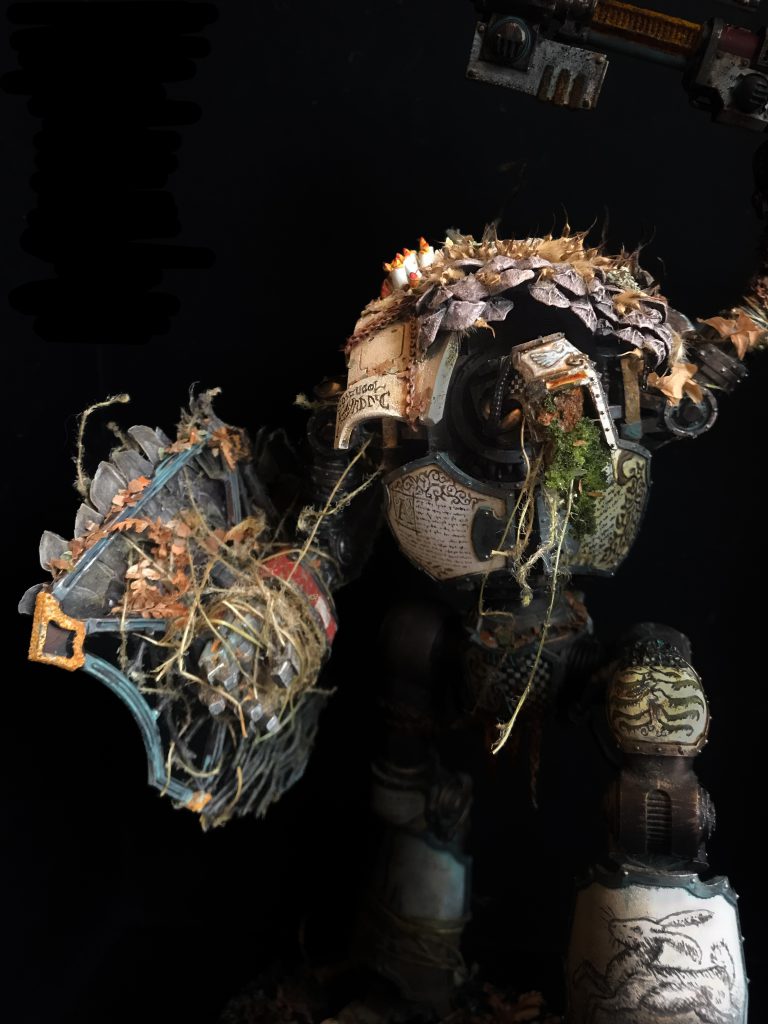
Initially this Knight was supposed to be THE Knight – Chaucer’s Green Knight by way of the recent film. In the building, I watched the movie again. There’s a promotional image where Gawain is brandishing an axe, and originally I wanted the Knight to echo that pose – a noble, wild and angry spirit. It kept not working. I hadn’t secured the joints, or I couldn’t work out how to lengthen the arm to achieve what I wanted, so I scrutinized the still from the movie again and again until it clicked with me what I wanted. Why would I want this avatar to be brandishing an axe, ready to deal out violence? Abuse is cyclical, generational, and I reject this as a possibility so utterly that I vibrate with the force of the feeling. So the lancer’s axe isn’t hostile. It is a man born of a violent system raising the instrument of that violence in salutation to the wonder of the world around him, because the world around him is wonderful. I want to raise that spear-that-is-me – O clouds unfold – to what I see every day – an incredible, vibrant, working class, multi-national, multi-cultural, multi-ethnic, multi-gender people who can create wonders. We are capable of wonders. If you’re reading this you are capable of wonderful things.
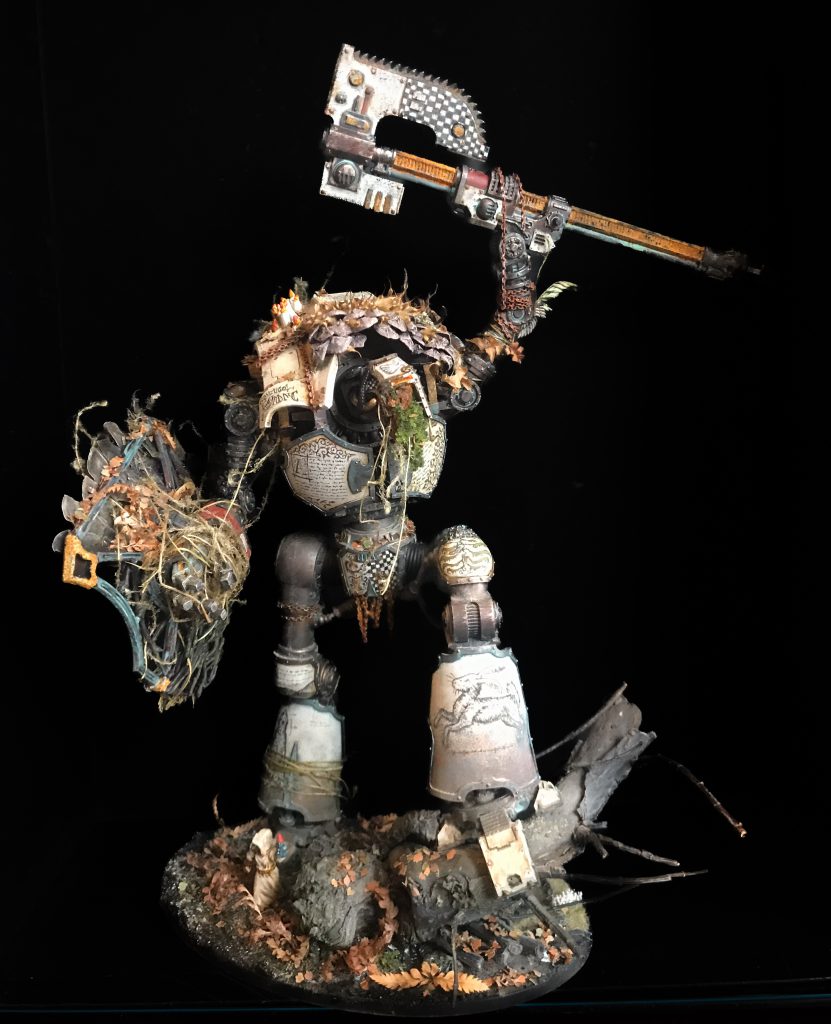
For uch gresse mot grow of graynes dede,
No whete were elles to wones wonne – the Pearl
The pose has wrenched the “hand” – the lance attachment – up and above the carapace of the knight, the whole model has been coaxed up and out of the crouch. It/I/We is/am/are no longer braced for impact, a hateful little thing hunched in on itself by a millennium of spite, but wide open to embrace the world, because I want to be. Once that was locked in, a lot of the tension I’d approached this with released and I felt free to explore, try out new things, go to new places. Suddenly, it became fun.
Land
Exploration begins in your land. You have to be careful, talking about land in the context of identity because fascist fuckwits turn that into “blood and soil” and that’s fucking nonsense. Soil has nowt to do with “blood”. Where you’re from is where you’re from, not where you were born or where the pig-fucking pathetic fash tell you it is. Ethnonarratives of land are fucked because the lands of my fathers are beautiful places, belonging to everybody, for us all to share.
Where I’m from is important to me – Britain, Wales, England, Yorkshire and Derbyshire. All are beautiful lands when wild and free, or calm and at peace. There’s a spirit there that cries out against fascist ethnonarratives, and for beauty and freedom and the right to roam. I want to be more connected to that spirit than I am. I live in a big, dirty, vibrant, wonderful city, but I feel disconnected from land, and sometimes that leaves me a little lost. As a result, the Knight had to be firmly, inextricably rooted.

This was both a modelling and a materials challenge – it’s all made from England (except the static grass), twigs, bark, stone, roots, sand and all, even the water effects used for mud are thinned with rainwater. My base is made of the substance of England, what I know England can be, but it has been turned into what it is. It has been eaten by capitalists, destroyed by bastards, gatekept by racists, drained by cowards and drowned in tarmac and concrete. The tree is crooked and fallen, trimmed by axe and saw. Water once flowed here, but now it is sewage filled and rotten. Land that was held in the commonwealth has been stolen, and sold. Mud has replaced grass. Hills have been flattened. Iron spikes are driven through tree, soil and creature. Darkness prevails.
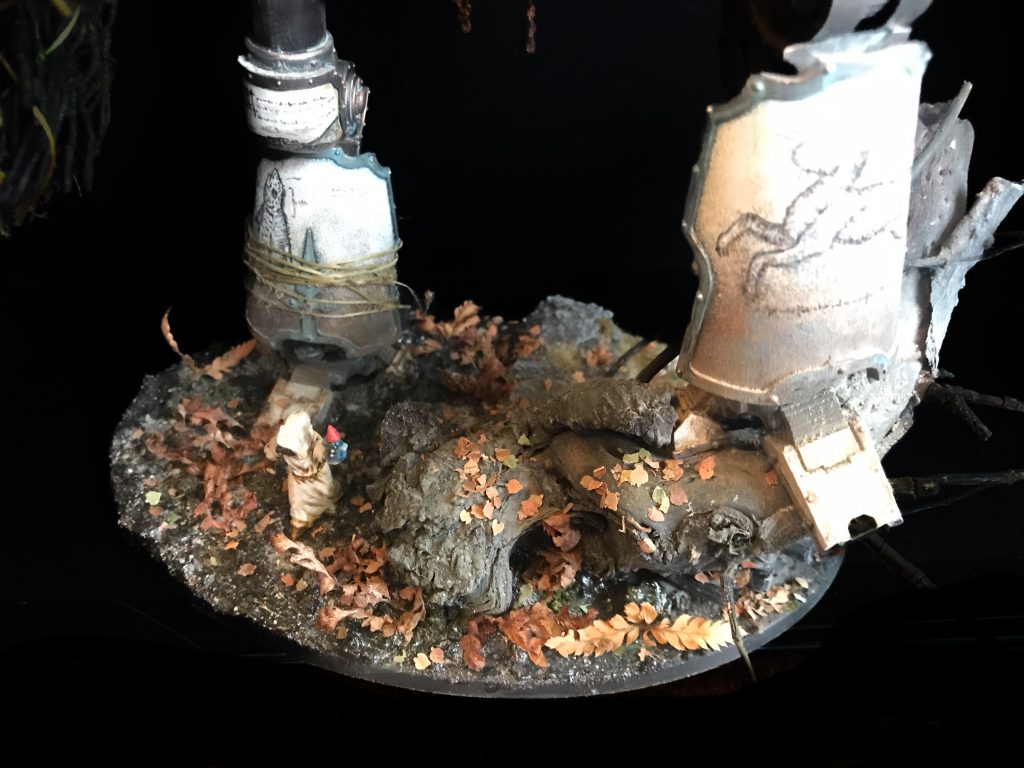
But I have hope, and that hope is a treasured part of myself. This isn’t a dead landscape, but a sleeping one. Come spring, the lands of the Knight will rise again once more into greenery. Spring will come. We won’t have shit-filled rivers and concrete choked fields forever and the valleys, both metaphorical and literal, will return to the wilds they were meant to be.

I am one of the Historicals editors here (check out our content, it’s good!), and I think it’s fair to say I am pretty stuck in the past. Both conceptually – where I draw inspiration from for Warhammer – personally, and politically too. It’s another thing I want to work on, to improve – so it again finds form in the knight, a kind of sympathetic magic to pull me onwards and upwards by example. We cannot move forward unless we are braced by our personal and political past – by the long and proud history of the labour movement, the anti-fascist movement, by every comrade that fought before us. Firmly planted in our past, we have a future to stride towards. The Knight does, because sometimes I can’t. Sometimes I’m too damn tired, or busy, or I find a million other excuses to turn away from life, to re-humanise myself and face from bloodshed. The footing slips, and next time you have to build yourself back up and reground yourself and go back to fighting the good fight. I find comfort in the past, and I probably spend more time thinking about Debs, Keller, Brockway, Hardie, Pankhurst, and Davis than I do about problems assailing us, problems I could perhaps be doing something about, in the modern day. “Am I doing enough” is a question that I use to diminish what I do to help, another form of harm, and another one I should reject. It was important, then, to create a pose of action – not just stepping forward, but ready to go on, when I choose to.

So the lancer is both mired in what these lands are, and striding forth into what they can be again. He is firmly planted in his roots, both thick sucking mud and green grass. He is poised to push on from dead wood and burnt life. The mud does not touch him, does not slow him. He is able to move through it and beyond it. He is weathered, and slow, and rusty, but he is alive and walks with purpose. He, and I, have places to be. Where they are I’m still not entirely sure – but I will get there, and the Knight is testament to a newly found determination to do so.
Wood
A shield defends, and defending what is good, and right, and just, seems to become harder every day at the moment. I have a lot more to defend and look after than I used to and the task has become more difficult. Neoliberalism has allowed – encouraged – darker and darker forces of right wing politics back into our public realm. Transphobia, homophobia, racism, conservative fuckwittery and naziism are full on back (they never went away), and they’re encouraged, emboldened, by politicians and idiot billionaires to a greater extent than ever before in my lifetime. I watch comrades – in life, in work, in the hobby – suffer, and I feel that I do not do enough. Since there is much to defend, the shield of the lancer became both the creative and, I suppose, spiritual focus of the project.
I am unquestionably naive to believe that there is something in us that turns us away from hatred. I choose to believe we are naturally good, so nature, again, became the subject and form of the shield. The lower half is wattle and daub – common building material in medieval Britain (and elsewhere of course) – made of milliput and twigs. The twigs are woven into wicker in what was the single stupidest thing I’ve ever done for a model. As you rise up the shield, the man-made wattle and daub fades into pine and leaf, the growth of strength and resilience in defense of what needs must be defended. Pine cones, seeds, leaves, form a crown, with the Grinning Green man at the heart of it.
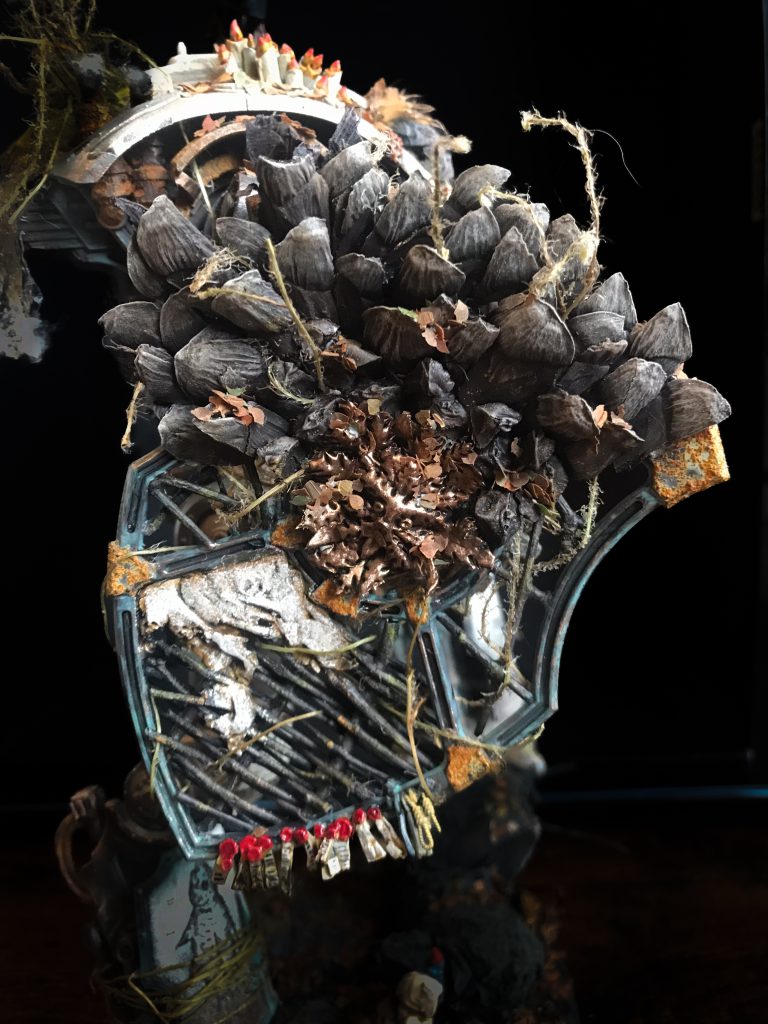
Defence must be alive. We cannot cower behind metal and stone, simply raising a ward between us and the world. Whether politically, economically, socially or even artistically, we must draw on what we believe to both keep us safe and project a better, more just, socialist, world. Life and love and justice spread and grow, a most irresistible force that can, will, does, break chains and concrete and tarmac and metal. Life spills from the shield across the knight, binding me and it to the call and opportunity to defend, to break whatever needs to be broken, to grow, to persist, to resist and change ourselves and the world around us. That is the spirit of the Green Man, to me. Once-and-future God, trickster, mocker of power, life and liberty and justice buried at the heart of Englishness, repressed but not gone. To rise like the sun.
And I’ve given it a big fucking axe too.
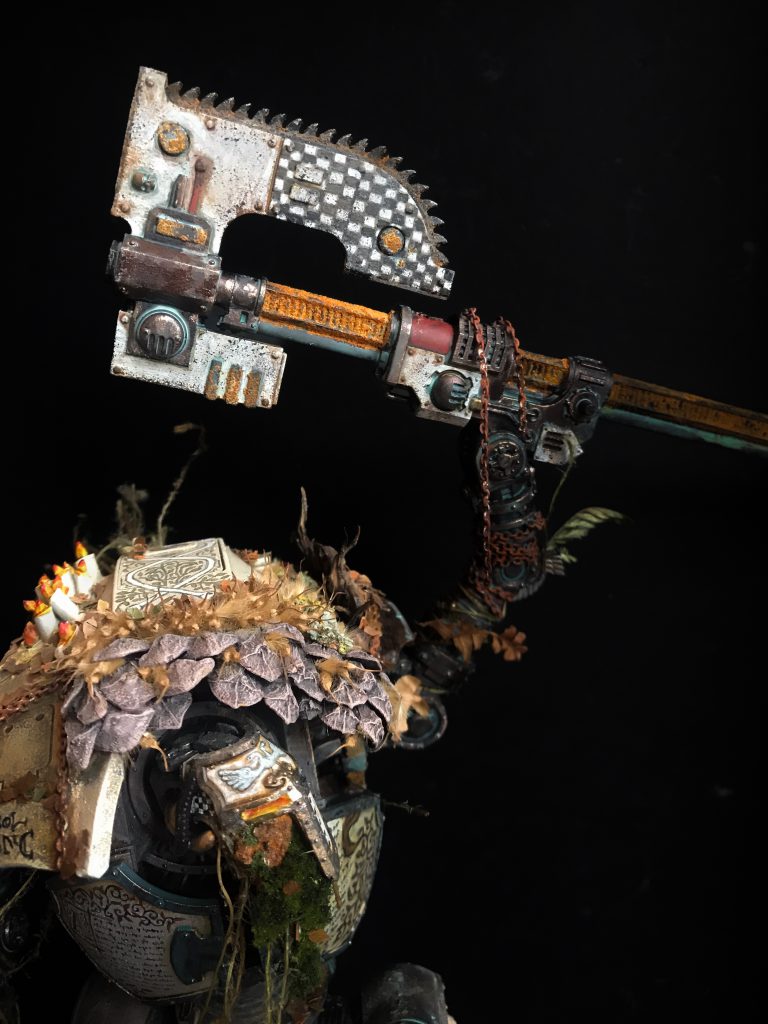
Skin
As I detailed and constructed the skin of the knight, all that armour plating, I placed chains around shoulders, hanging from plates and weapons and particularly around the left arm. I started with the elbow, because the lengthened and bent arm looked wrong – smaller and thinner than I’d like it to be, someone else’s arm affixed to my body, a little touch of body dysmorphia that I share with the knight. My left arm isn’t quite right – it’s covered in scars, marks of the long war. They’re old now and I kept them hidden for many years, my consumptive-pale skin keeping them bright and highly visible for decades, but I don’t mind them anymore. I had all sorts of reasons for giving myself scars, and all sorts of excellent excuses for carrying around flint, or steel, to do so. I got myself through it – with family, friend, partner, pharmaceutical and medical – support. I sometimes feel like I’ve beaten one set of odds, because while the call of the void will never leave, I see it for what it is. Before 35 – or 45 if you’re male, the biggest cause of our end is ourselves, but there is hope within us if we are supported and helped to access it. I lived, and continue to live. Many, so many, did not, and the weight of that is sometimes crushing. Now, my scars help me to remember not that it could be worse, but that I made it better, and, if needed, I can make it better again.
So the knight got my scars along its arm and shoulders. They were painted differently – a little redder, a little more like mine – than those elsewhere on the model. They work structurally, decoratively, and metaphorically. They aren’t battle damage, inflicted by an outside force, but an integral part of him – and me.
Chains are part of the build, but skin is much more than scar tissue. I enjoy messing about with Knight carapaces and armour plating, and echoed my previous knight builds in leaving the shoulders more or less bare, chopping up bits of Questoris carapace to make the knight off-centre and asymmetric. The front was hacked off and replaced with layered pine scales, that weight of nature and hope taking up a prominent spot, adding seed cases into the pine scales to hint towards a pelt. Candles, chains, and real lichen add a lot of texture while keeping the literal and metaphorical hope for a living future visually key. Once the main body was finished, I ground up some lichen and mixed it with whole milk, painting this on the majority of the model. It stank for a couple of days but hopefully will have kick-started lichen growth in all the nooks and crannies. I’ll let you know if this worked in about ten years.

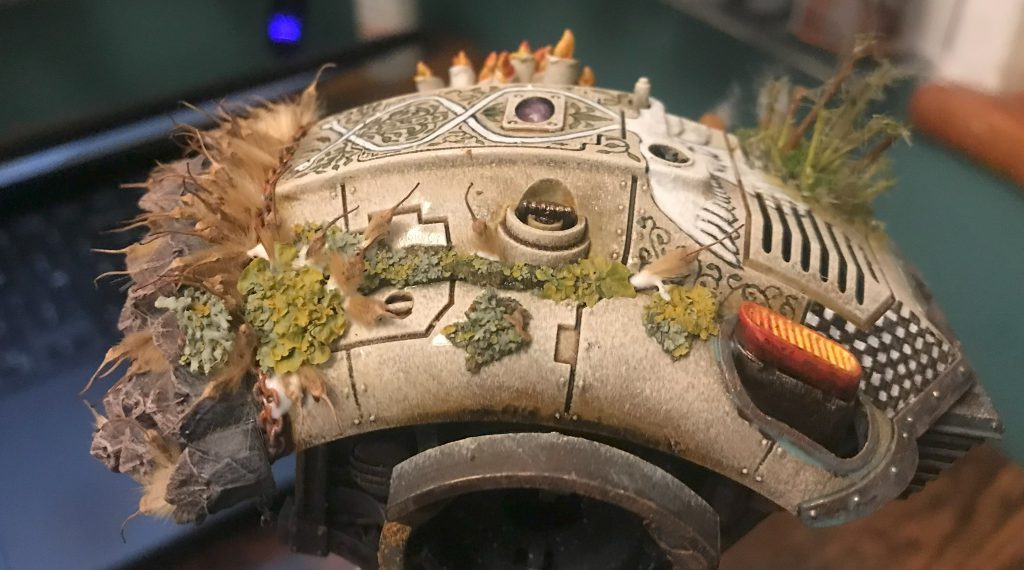
I worked harder on the carapace than anywhere else – with a bit of freehand inspired by the great socialist artist and visionary, William Morris, and then with checks, candles, and fern roots. There’s a lot of organic components on there and the process was too – deciding without plan or design what I’d include on each section. With chaos reigning, it slowly began to look truly alive, at least partially because a lot of it was when I was adding it to the model. Greenery bursts out of every crevice and winds its own irrepressible way around the knight. Life cannot exist without water, so a wellspring bubbles up from the vents, corroding and wearing away industry and, perhaps, cleansing the polluted world the Knight strides through. I couldn’t have been much more on the nose with this one if I tried, so there’s not a lot to say about it, eh?
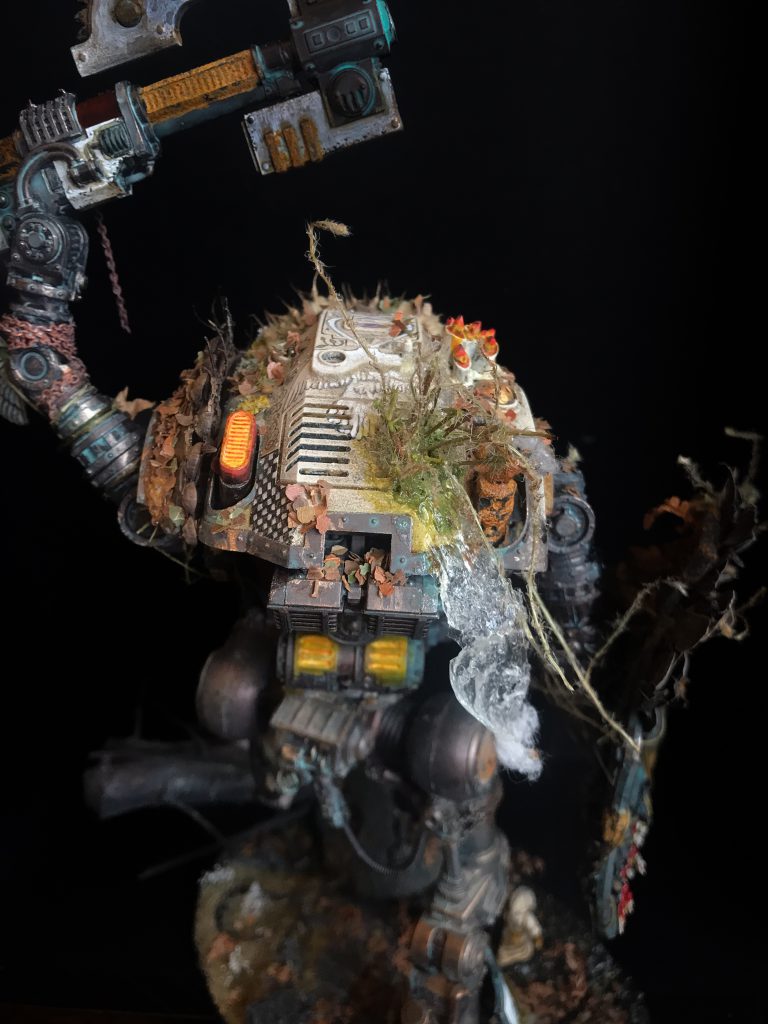
Ash
I am not a pagan, despite the fact that I thank streams when I cross them. Nevertheless, there’s some kind of spiritual and ritual power in magical practice that I think I might legitimately believe in these days, because faith has to go somewhere, right? I ended up indulging in a little magical practice for the painting – grinding up ash, collecting rain water to wash my brushes in, little poems and prayers said aloud to an indifferent workbench. It has all, hopefully, ended up in the paint. Each paint used on the armour of the knight has at least a little ash added to it. Some of it is from fallen oak wood gathered in Derbyshire which went into the bone and whites, leaving them greyed and muted. Some of it is me, carefully trimmed beard hair burnt – much to my olfactory disgust – in the garden.
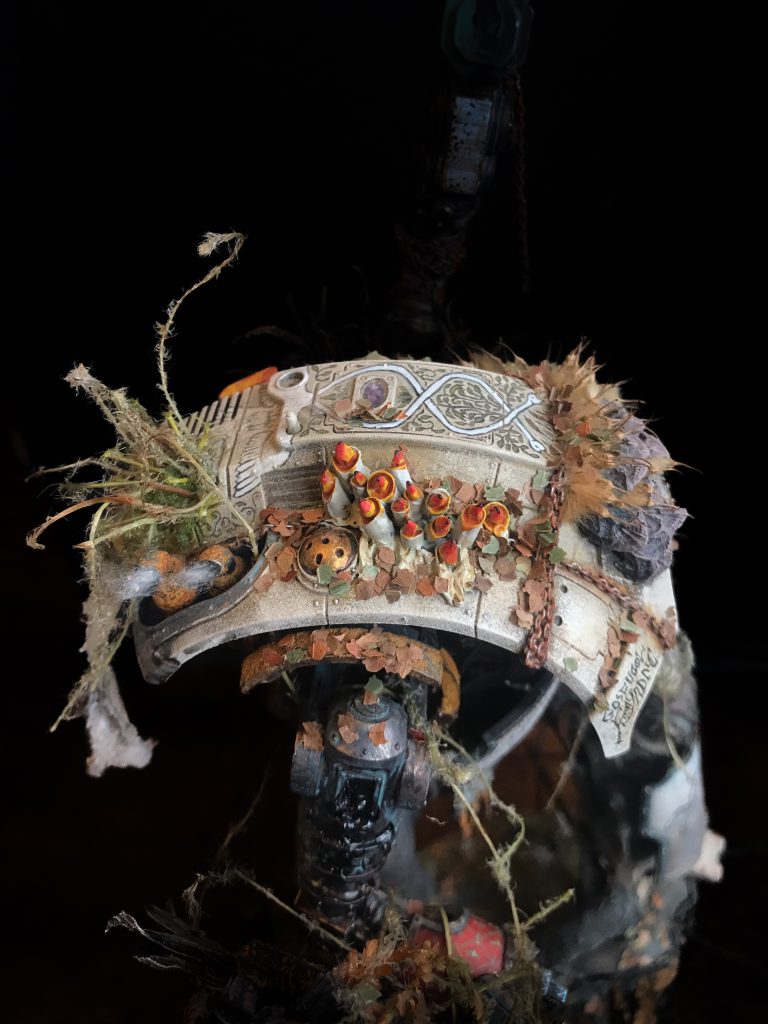 I don’t know if they’ve added much, visually. The painting is as my painting always is – sloppy in places, bedecked with checks, applied with a sponge, drenched in wash and shade. I used only techniques I enjoy (no high quality OSL here!), and relaxed into the painting, doing freehand where I wished and letting the sponge fall where it may. The bones are messy oxidised copper, the plates bone. I didn’t rush it, but I didn’t take my time with it either. Many sections were stripped and painted over and stripped again, both knee pads going through perhaps a dozen iterations before I felt satisfied. This sounds frustrating, but it wasn’t. It’s how I enjoy painting like this, working on the fly, experimenting, scrapping things that don’t work, learning a lesson on each piece even if it’s a lesson that I shouldn’t try X technique again without preparing. It doesn’t matter if the ash and the water and the poetry changed how it looks. It changed how it felt to paint.
I don’t know if they’ve added much, visually. The painting is as my painting always is – sloppy in places, bedecked with checks, applied with a sponge, drenched in wash and shade. I used only techniques I enjoy (no high quality OSL here!), and relaxed into the painting, doing freehand where I wished and letting the sponge fall where it may. The bones are messy oxidised copper, the plates bone. I didn’t rush it, but I didn’t take my time with it either. Many sections were stripped and painted over and stripped again, both knee pads going through perhaps a dozen iterations before I felt satisfied. This sounds frustrating, but it wasn’t. It’s how I enjoy painting like this, working on the fly, experimenting, scrapping things that don’t work, learning a lesson on each piece even if it’s a lesson that I shouldn’t try X technique again without preparing. It doesn’t matter if the ash and the water and the poetry changed how it looks. It changed how it felt to paint.
When it came to the leg plates I felt I had little option. Over the last few months I’ve been listening to – perhaps even meditating on – the work of Shirley Collins, one of England’s great folk singers. I have sung Hares on the Mountain to my son many, many times to help him sleep, and to provide warm, dark and peaceful moments between the two of us that are precious beyond all measure. It’s right, and just, that the Hare and the Fish would appear on the knight. Alongside the hare comes the goose – repeated in a couple of places on the armour plating. Geese are pretty great as a bird anyway, but the Geese are there as a personal connection to a favourite piece of Englishness – the spirit of rebellion. I would (and I did, in a previous draft) go on here about why the Goose, but someone said it much better than I, several centuries ago:
The law locks up the man or woman
Who steals the goose from off the common
But leaves the greater villain loose
Who steals the common from the goose
And geese will still a common lack
Till they go and steal it back
Perhaps this whole thing is about being a goose. Go and take back what has been taken from you – time, identity, pride, land, wealth, love. Whatever it was, capital stole it and the right wing enforces the theft with violence, fear and greed. But you – I, we, us, all comrades together – can take it back. If we – if I – am not a goose, it is time to become one, the Gosfugol Fyndric, the Warrior Goose.
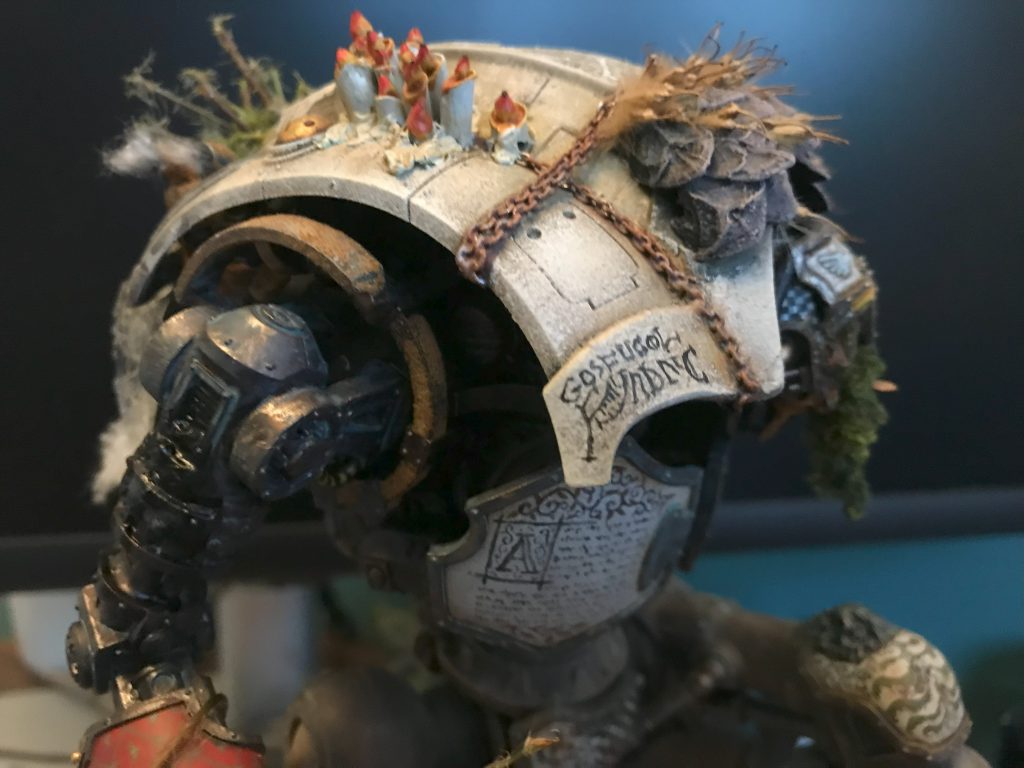
Love
I made this as the leaves turned on the trees, and I finished the build auspiciously on the autumn equinox and I’ve published it on the winter solstice (it should publish at sunset – if you didn’t guess from the poetry, can’t resist a bit of pretention). All throughout I have watched leaves fall and amass around me, so it was right and proper to do that for the knight. I got unexpectedly emotional doing this, because it triggered memories of a colleague and I talking about autumn leaves while she watched me sweep them up at a long-ago job. She isn’t here now, and I miss her. Our hobby is, despite what some people might think, quite a queer space, a goth space, a mental health issue space, a space for people who might not have fitted in particularly well with the world around us at various points in our lives, and that means that loss is all around us. When I was punching out leaves, dropping them onto the Knight and then carefully fixing them in place with mounting spray, I was thinking about those people that we have lost, both individually and as a community, and thanking them for their time with us, no matter how brief.
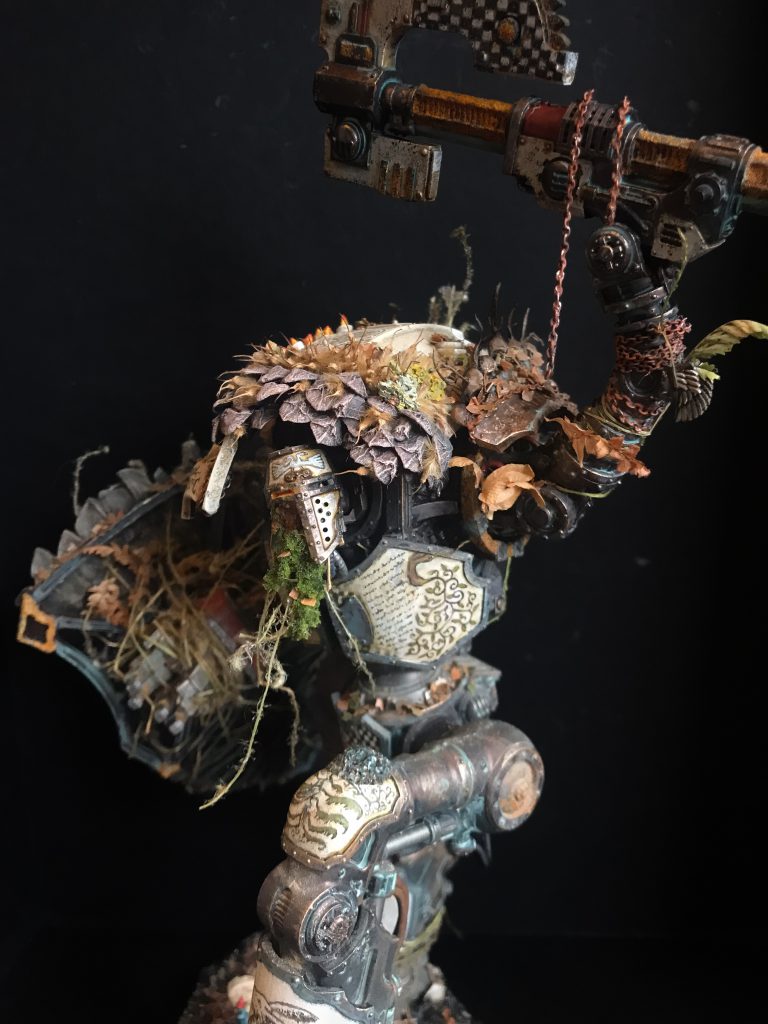
I am still here, and the knight is proof of that. He has taken his place amongst the family of knights, taller and prouder than any of them, unbowed and unbroken. He’ll never be finished – more height is on the to do list, there’s something, but I’m not sure what, missing around the neck, birds, flowers, servo-skulls, cherubs, but that’s ok. We are all of us a work in progress. So the leaves are the last of him, for now. It works as well as a metaphor as anything else. Leaves fall every year, and they regrow. We fall dormant, but we are still here, still capable of growth once the winter has passed. I am still here, and I have much more growing to do. You are still here too, and I am glad of it.
Questions, comments, suggestions? Contact@goonhammer.com or leave a comment below
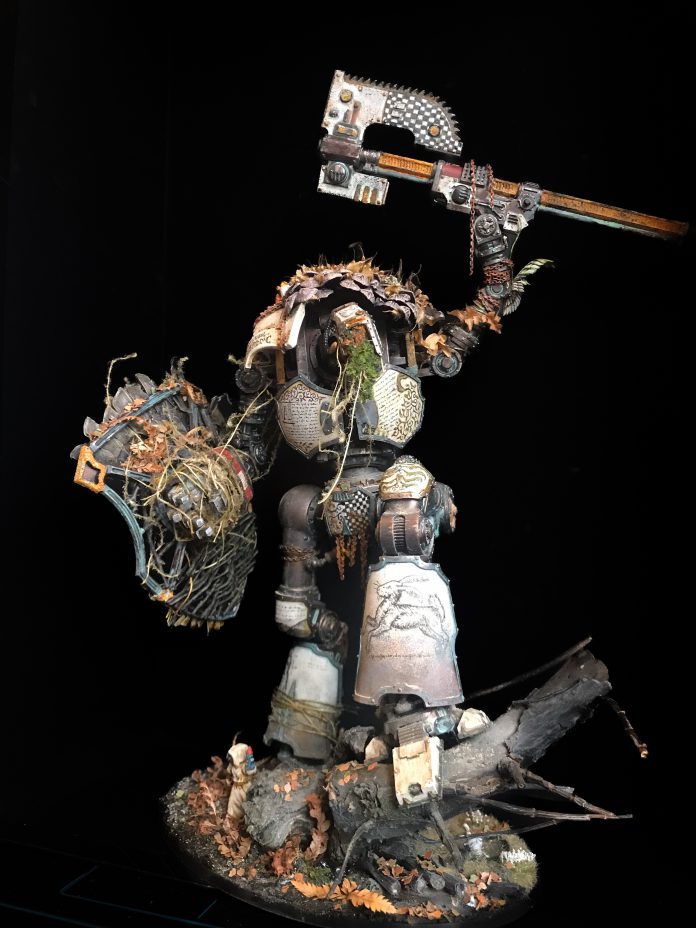
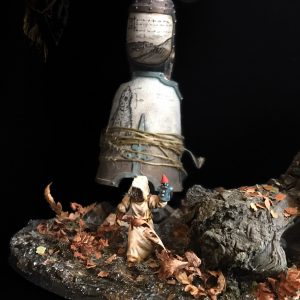

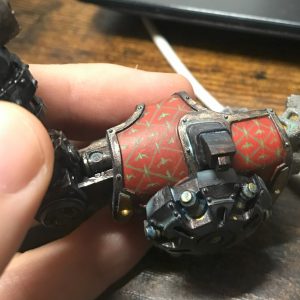
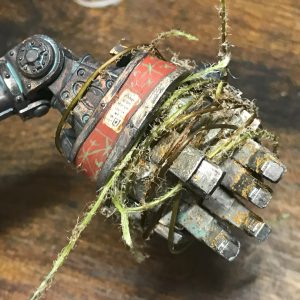
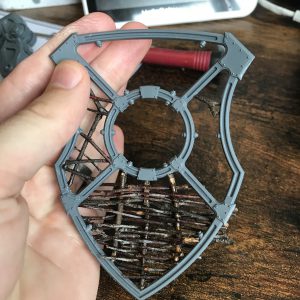
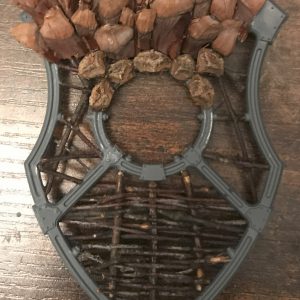
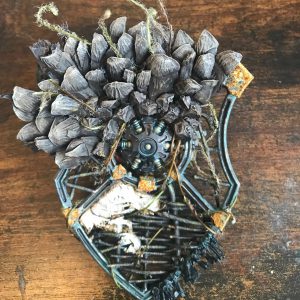
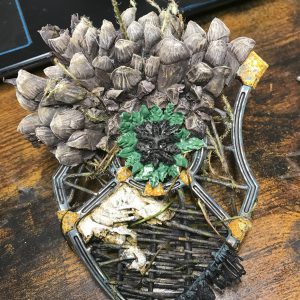

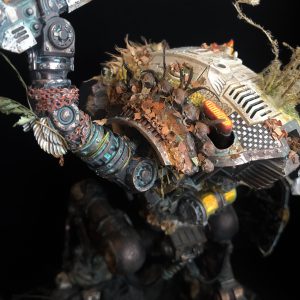

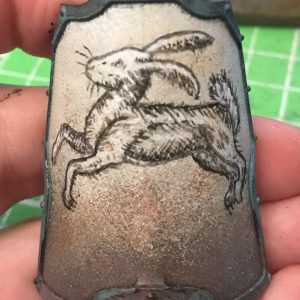




You must be logged in to post a comment.